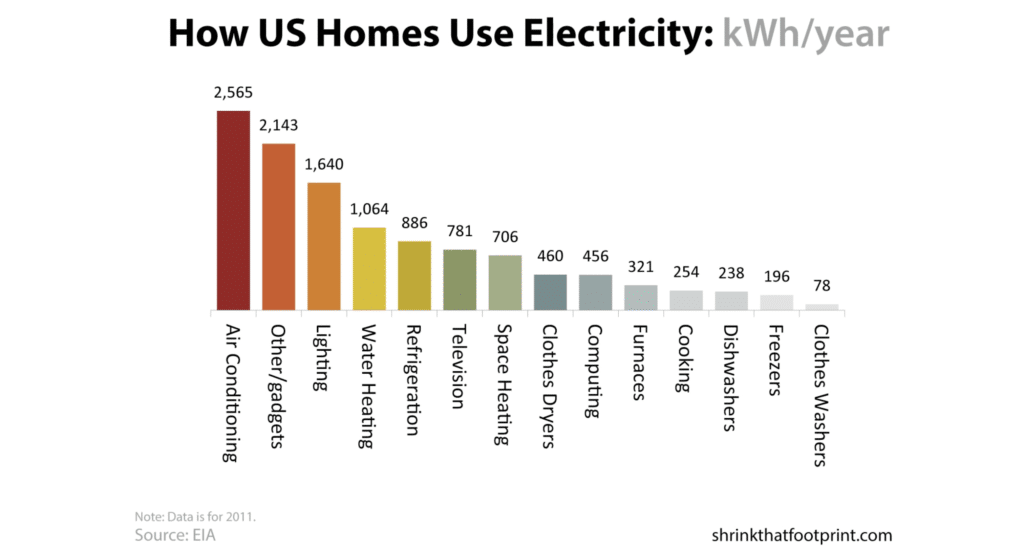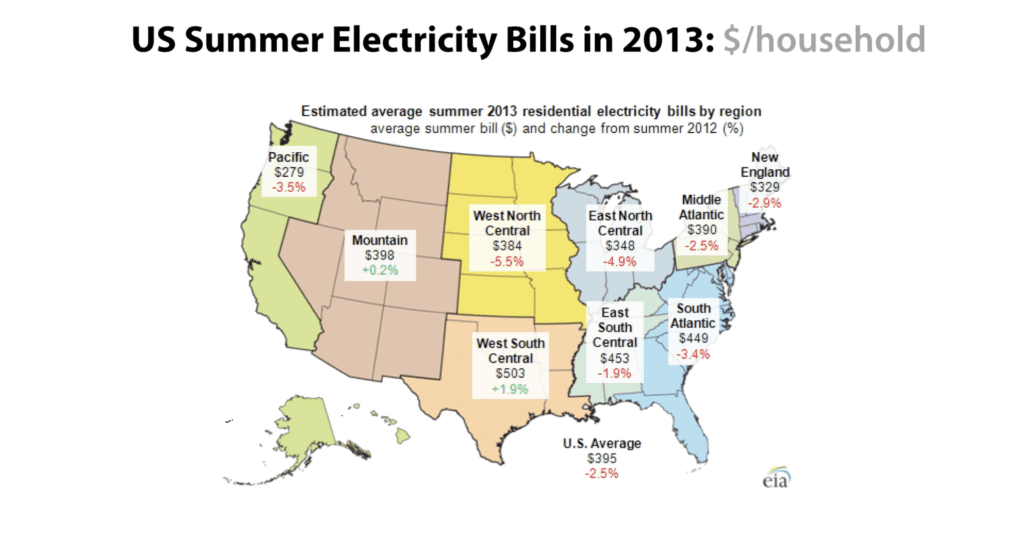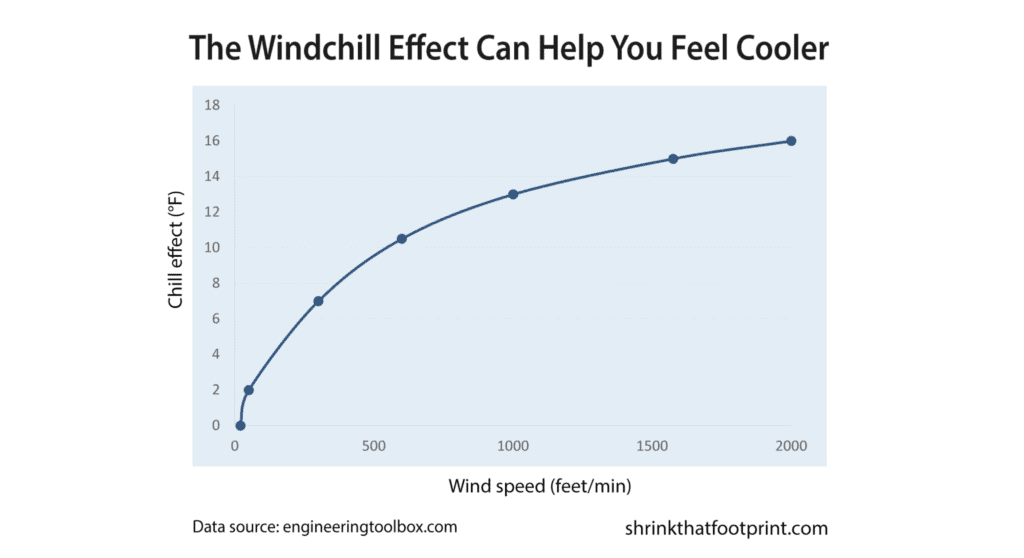We Introduce 5 Strategies To Reduce AC Bill For The Home
AC running all summer? Want to know how to reduce the AC bill? Staying cool without breaking the bank can be tough if you live somewhere hot. It can be tough to keep your home cool in the summer without racking up a high electricity bill. AC consumes one fifth of all electricity making it one of the biggest users of electricity in a home. This is especially true in the south eastern part of the US.

Comparing between two extremes, the Pacific Northwest and the South, shows a $200 difference in AC costs. The different areas that define costs reflect the reality of climate zones in the US.

Luckily, here are 5 strategies you can use to reduce the AC bill.
1. Plan Ahead Using Knowledge Of Activities And Forecasts To Reduce AC Bill
One way to reduce your ac bill is to plan ahead. If you know it’s going to be a hot day, open your windows in the morning to let in cooler air. Close them again once the outside temperature starts to rise. This will help keep your home cooler throughout the day. In order to get numbers, check here to get an idea for the amount of electricity used by your air conditioner.
Just like with heating, you don’t necessarily need to have your house at full blast when you’re at work or you’re asleep. By carefully programming the thermostat on your air-conditioner unit, you can make sure you maximize the amount of comfort you get without wasting electricity.
Smart thermostats from Nest and Honeywell are really fantastic for granular control of home cooling. We have written up more detailed tips for achieving eco-friendly air conditioning solutions.
2. Use Fans To Take Advantage Of Your Body’s Evaporative Cooling
Another tip is to use fans instead of air conditioning when possible. Fans use much less energy than air conditioners, so they’ll save you money on your electricity bill.
When the weather gets cold, people often talk about how it’s even cooler when you account for the windchill effect. By carefully using standing and ceiling fans, you can feel a degree or two cooler without actually changing the temperature in your room. And because fans use such limited electricity when compared to central air-conditioning, this is always a win in terms of energy.

Does using a fan reduce temperatures? In short, no, a fan doesn’t reduce temperatures. In more detail, the answer is complicated. Fans cool by a process called evaporative cooling. Minute amounts of moisture near the skin for example from sweat, will evaporate into the air. When the moisture evaporates, it carries off a bit of energy leaving the skin cooler. The heat goes into the air. Overall, the temperature of the room hasn’t changed. No heat has been added or removed from the the system of you plus the room.
However, near your skin, the temperature will have cooled down a bit, and only briefly. Fans circulate and enhance evaporative by moving the air around so dry air is constantly wicking moisture away.
3. Insulate Your House Better To Reduce AC Bill
Insulation isn’t only for keeping a house warm. It also keeps a house cool! This is because insulation cuts down on heat exchange which is bidirectional. In the summer you want to reduce heat exchange by keeping heat out. In the winer you want to reduce heat exchange by keeping it in. Check for air leaks around doors and windows, and make sure your attic is properly insulated. These simple steps will help keep the heat out and the cool air in.
4. Turn Off Heat-Generating Appliances
Avoid using heat-generating appliances during the hottest hours of the day. If you can, do your laundry, run the dishwasher, and cook dinner in the morning or evening when it’s cooler outside.

5. Turn Up The Thermostat
Adjusting your thermostat setting by a degree or two is probably the fastest and easy way to cut down on bills. If you use a very cool thermostat setting in the 60s or low 70s Fahrenheit, then you’re going to be paying a lot for your air conditioning. Personally, I think this strategy is a touch more limited than is the case with heating because in a cold time if you just put on a jumper, whereas if your home really does start to overheat it can be quite uncomfortable. But raising the thermostat by a degree or two can make great savings.
6. Maintain Your AC For Better Efficiency
Dirty or blocked air conditioning filters can easily reduce the efficiency of your air conditioner by five to twenty percent. So you really want to keep them clean. Other maintenance ideas to consider are making sure the condenser coil is clean and making sure your air conditioning system is regularly serviced. We cover at least one issue with frozen AC troubleshooting.
To make sure your home’s not overheating to begin with, make sure you deploy all the curtains, blinds and shades that you have at your disposal to reduce the amount of sun’s energy entering your home. If you’ve got the time or the cash you can also consider looking at cool roof technologies or planting trees to improve shading during summer months. We provide a review of blinds that insulate which provide double duty of blocking light and preventing heat from entering or leaving.
7. Install A More Efficient AC
Perennial problem of small houses without ductwork is installing central air in a house without ducts. However, it turns out that a ductless system could be better anyway. A ductless system is more efficient than central ducted air conditioning because it does not require the use of ductwork or large air handlers. Ductless systems can provide a more precise level of cooling, since individual zones can be controlled to maintain desired temperatures in different areas of the home. Ductless systems also allow for more flexibility in terms of installation, as the individual units can be mounted on walls or ceilings. Additionally, ductless systems are quieter than traditional air conditioners, and can reduce energy costs by up to 30%.
Conclusions
If you want to cut your air conditioning bill, remember to turn up the thermostat within reason. Improve air flow by using fans program your cooling to work efficiently. Maintain your air conditioning system and improve shading and reflection. We’ll catch you tomorrow looking at the carbon intensity of your electricity.
Last please take a look also at our strategy for cutting your heating bill.
Lindsay Wilson
I founded Shrink That Footprint in November 2012, after a long period of research. For many years I have calculated, studied and worked with carbon footprints, and Shrink That Footprint is that interest come to life.
I have an Economics degree from UCL, have previously worked as an energy efficiency analyst at BNEF and continue to work as a strategy consultant at Maneas. I have consulted to numerous clients in energy and finance, as well as the World Economic Forum.
When I’m not crunching carbon footprints you’ll often find me helping my two year old son tend to the tomatoes, salad and peppers growing in our upcycled greenhouse.
